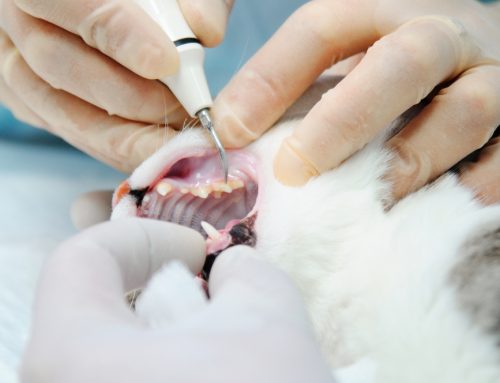You may not realize that your pet has added a few pounds to their waist line, but you should be concerned if their weight is increasing. Pets are considered overweight if they are 10 to 20 percent heavier than their ideal weight, and obesity can significantly jeopardize your pet’s health and quality of life. Here are seven reasons why you should be concerned about your pet’s extra “fluff.”
#1: Obesity puts your pet at higher risk for developing diabetes
As food is digested, sugars are absorbed in the intestine and converted to simple sugars, including glucose. Glucose then enters the bloodstream, to provide energy for the body’s cells. Insulin is needed for the cells to use the glucose. Diabetes occurs when the body cannot use glucose normally. Obese pets are at higher risk for developing type II diabetes mellitus. The insulin receptors on their fat and muscle cells are reduced in number, damaged, or do not function properly, which results in increased circulating insulin and blood glucose levels. Diabetes signs include increased appetite, increased thirst and urination, unexplained weight loss, and chronic or recurring infections. Dogs can also develop cataracts, which obstruct their vision, and make their eyes appear cloudy. Diabetic pets require lifelong treatment, including special diets, a tailored fitness regimen, and daily insulin injections, as well as frequent veterinary monitoring, to ensure their insulin dose is accurate. Caring for a diabetic pet is time-consuming and expensive, and if their insulin levels are not controlled properly, they can face life-threatening consequences.
#2: Obesity puts your pet at higher risk for developing high blood pressure
The exact mechanism is not known, but obese pets are at higher risk for developing high blood pressure. This condition causes several serious health complications, including:
- Congestive heart failure — High blood pressure forces the heart to work harder to pump blood throughout the body, causing the heart muscle to thicken on the left side. This ultimately results in congestive heart failure.
- Kidney failure — High blood pressure damages the arteries around the kidney, resulting in insufficient blood supply to the kidney tissue. Damaged kidney cells cannot filter the blood properly, resulting in kidney failure.
- Stroke — High blood pressure can damage the arteries that supply blood to the brain, causing them to burst or be blocked.
- Retinal degeneration — High blood pressure can damage the arteries supplying blood to the retina, resulting in degeneration, and possibly retinal detachment. This can cause blindness.
Pets do not exhibit any signs when initially affected by high blood pressure. The best way to monitor for this condition is regular veterinary wellness exams for your pet. As the condition progresses, signs can include increased thirst and urination, nose bleeding, depression, disorientation, and sudden blindness.
#3: Obesity puts your pet at higher risk for developing kidney failure
In addition to high blood pressure causing kidney failure, obese pets also have higher hyaluronic acid levels inside their kidneys. This lubricating material is responsible for helping cartilage resist compression, and accumulation in the kidneys damages the cells, eventually resulting in kidney failure. As toxins build up in the blood, signs include lethargy, increased thirst and urination, and an unkempt appearance. As the condition progresses, signs include decreased appetite, vomiting, diarrhea, and foul smelling breath.
#4: Obesity puts your pet at higher risk for developing respiratory disease
Excess fat causes the diaphragm, lungs, and chest cavity to mechanically compress, which can lead to restrictive pulmonary damage. In obese pets, their respiratory compliance typically decreases, pulmonary resistance increases, and their respiratory muscle strength is reduced. This can cause excessive panting and fatigue after only mild to moderate exercise.
#5: Obesity puts your pet at higher risk for developing arthritis
The excess weight on an obese pet’s joints results in cartilage breakdown, leading to arthritis. Excess fat cells also produce inflammatory products (i.e., adipokines) that target all joints, including non-weight bearing structures. Many pets, especially cats, do not show signs indicating joint pain, and end up suffering in silence.
#6:Obesity puts your pet at higher risk for developing cancer
Chronic inflammation caused by excess fat cells leads to cancer. At least 13 cancers are linked to obesity in humans, and animal models used in cancer research suggest that pets are also at higher risk for developing cancer.
#7: Obesity decreases your pet’s quality of life

Obese pets are not able to enjoy interacting with their family and other pets. They cannot run and play like pets kept at an ideal weight, and their health issues cause them to feel unwell.
Obesity in pets can be managed through diet, exercise, and addressing any underlying health issues. The first step toward helping your pet lose weight is a veterinary professional’s evaluation, to ensure conditions such as hypothyroidism or Cushing’s disease are not contributing to their weight gain. Once their medical conditions have been addressed, a weight loss program can be devised especially for your pet, to help them lose weight, and regain their vitality for life. If you would like your pet evaluated, to see if they are a candidate for a weight loss program, do not hesitate to contact Bolton Veterinary Hospital to schedule an appointment.







Leave A Comment